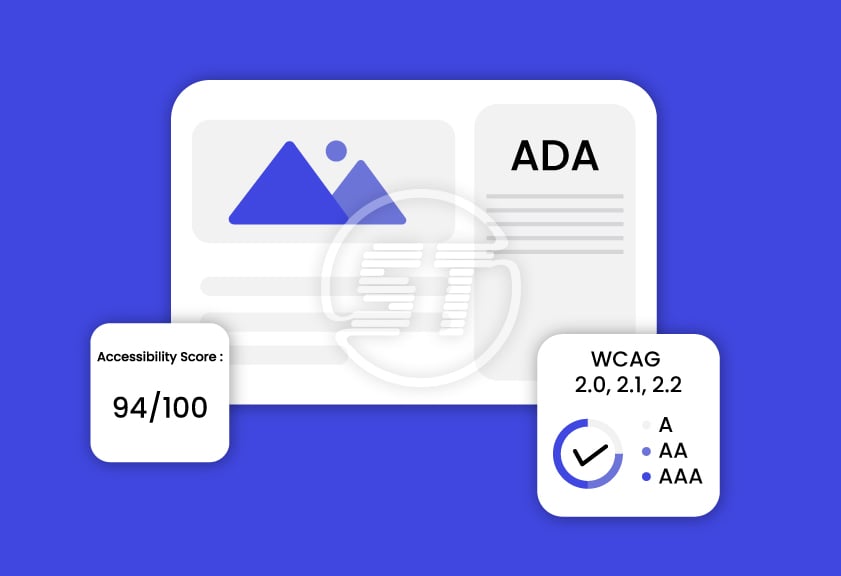A website is often the front door to a business or organization. But what happens when that door is inaccessible to millions of people with disabilities? Beyond being a significant oversight, it’s a potential violation of the Americans with Disabilities Act (ADA). Ensuring website accessibility is not just a moral obligation – it’s a legal requirement and a critical step toward inclusivity.
This is where ADA compliance checkers come into play. These tools act as digital accessibility inspectors, systematically evaluating websites to uncover barriers that might prevent users with disabilities from fully engaging with online content.
Let’s understand how an ADA compliance checker tool works and what it looks for in its quest to make the web a more inclusive space.
What is ADA compliance and compliance checkers?
The ADA mandates that businesses and organizations provide equal access to their services, including websites, for people with disabilities. Accessibility guidelines, such as the Web Content Accessibility Guidelines (WCAG), provide a framework to achieve this. These guidelines define success criteria that ensure a website is Perceivable, Operable, Understandable, and Robust (POUR) for all users.
ADA compliance checkers are software tools designed to evaluate websites against these accessibility standards and identify areas that may pose barriers to accessibility.
How do ADA compliance checkers evaluate website accessibility?
ADA compliance checkers use advanced algorithms and automated processes to analyze a website. Here is what they evaluate:
- Website structure and navigation
Navigation is crucial for users relying on screen readers or keyboard-only input. ADA compliance checkers analyze:
- Heading structure: Are all headings organized hierarchically (H1, H2, H3, etc.)?
- ARIA Landmarks: Are ARIA landmarks appropriately used to define page regions?
- Keyboard navigation: Can all elements be accessed and operated using only the keyboard?
- Text alternatives
Images and multimedia content need descriptive text for visually impaired users relying on screen readers. Checkers review:
- Alt text: Are meaningful images accompanied by descriptive alternative text?
- Complex images: Are charts, graphs, or infographics provided with text descriptions or data tables?
- Color and contrast
Low-contrast text can be challenging for users with visual impairments. ADA checkers assess:
- Color contrast ratios: Do foreground and background colors meet WCAG minimum contrast requirements?
- Color reliance: Are color-coded elements supplemented with text or symbols?
Check out our WCAG color contrast checker tool for more information.
- Multimedia content
Video and audio content should include accommodations for users with hearing or visual impairments. Tools evaluate:
- Captions and transcripts: Are captions provided for videos? Are transcripts available for audio content?
- Audio descriptions: Do videos include descriptions of visual elements?
- Forms and input fields
Forms must be accessible to all users, including those using assistive technologies. Checkers review:
- Labels and instructions: Are form fields clearly labeled and descriptive?
- Error messages: Are error messages provided in a way that assistive technology can interpret?
- Keyboard operability: Can forms be completed without a mouse?
- Dynamic content
Websites often include dynamic elements like pop-ups or interactive widgets. Compliance checkers analyze:
- ARIA roles and properties: Are ARIA attributes used correctly to make dynamic content accessible?
- Focus management: Does the keyboard focus shift appropriately when interacting with dynamic elements?
- Responsiveness and device compatibility
Websites must function across a variety of devices and screen sizes. Checkers test:
- Responsive design: Does the site adapt to different screen resolutions and orientations?
- Mobile accessibility: Are touch targets large enough and spaced adequately for users with motor impairments?
Limitations of automated checkers
While ADA compliance checkers are invaluable for identifying common issues, they have limitations:
- Contextual understanding
Automated tools may struggle to assess nuanced issues, such as the appropriateness of alt text or the clarity of error messages.
- Manual review
Human expertise is essential to complement automated evaluations and ensure compliance with subjective WCAG criteria. Kickstart your accessibility journey with manual WCAG accessibility audit, and get a compliance roadmap for accessibility barriers as per WCAG 2.0, 2.1, and 2.2 guidelines!
How can Skynet Technologies help with ADA compliance checkers?
Skynet Technologies has developed Website Accessibility Checker, one of those in-house tools that helps organizations to check their website’s accessibility status
It is a free tool that scans websites for ADA, WCAG, UK Equality Act, Canada ACA, Australian DDA, California Unruh, Israeli Standard 5568, and European EN 301549.
How it works?
To scan a website, its URL needs to be entered. The Website Accessibility Checker will furnish the audit report. Then, organizations can fix the accessibility issues according to the reports.
The checker conducts an array of accessibility tests to detect various issues for WCAG and other international accessibility standards. Issues such as color contrast, missing or incorrect ARIA attributes, broken links, image alt text, HTML structural elements, etc.
Wrapping up
Automated ADA / WCAG compliance checkers play a vital role in ensuring websites are accessible to all users. By evaluating key aspects like structure, text alternatives, and multimedia content, these tools help organizations identify and address accessibility barriers. However, a comprehensive website WCAG accessibility remediation requires a combination of automated tools, manual testing, and a commitment to inclusive design principles. By prioritizing accessibility, organizations not only meet legal requirements but also create a more inclusive digital landscape for everyone. For more information, request a free ADA website accessibility remediation quote or email us at [email protected].


